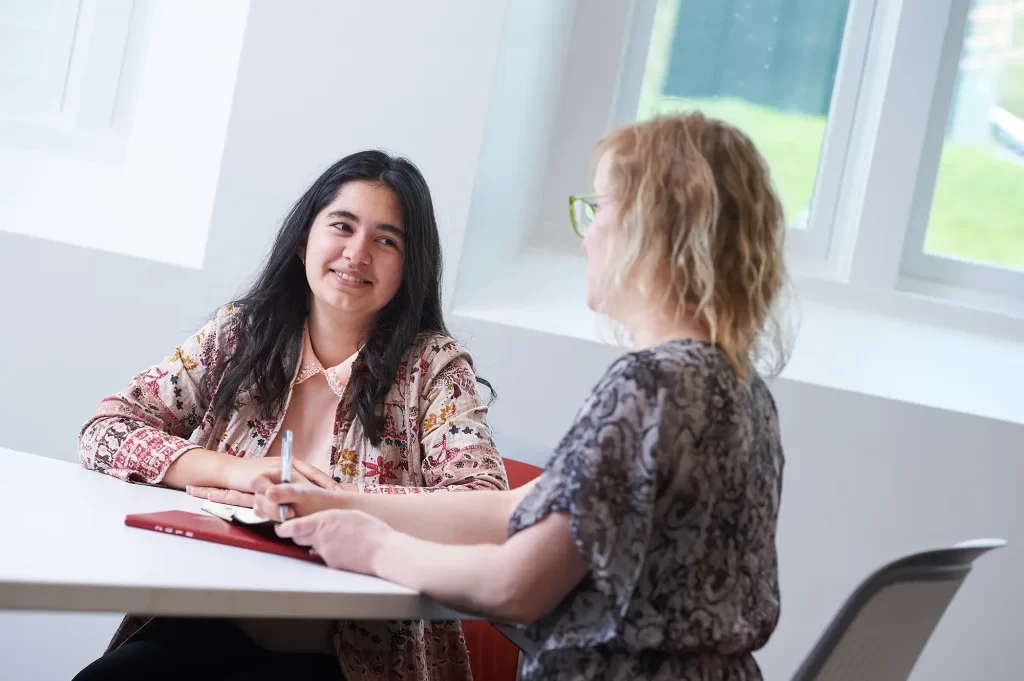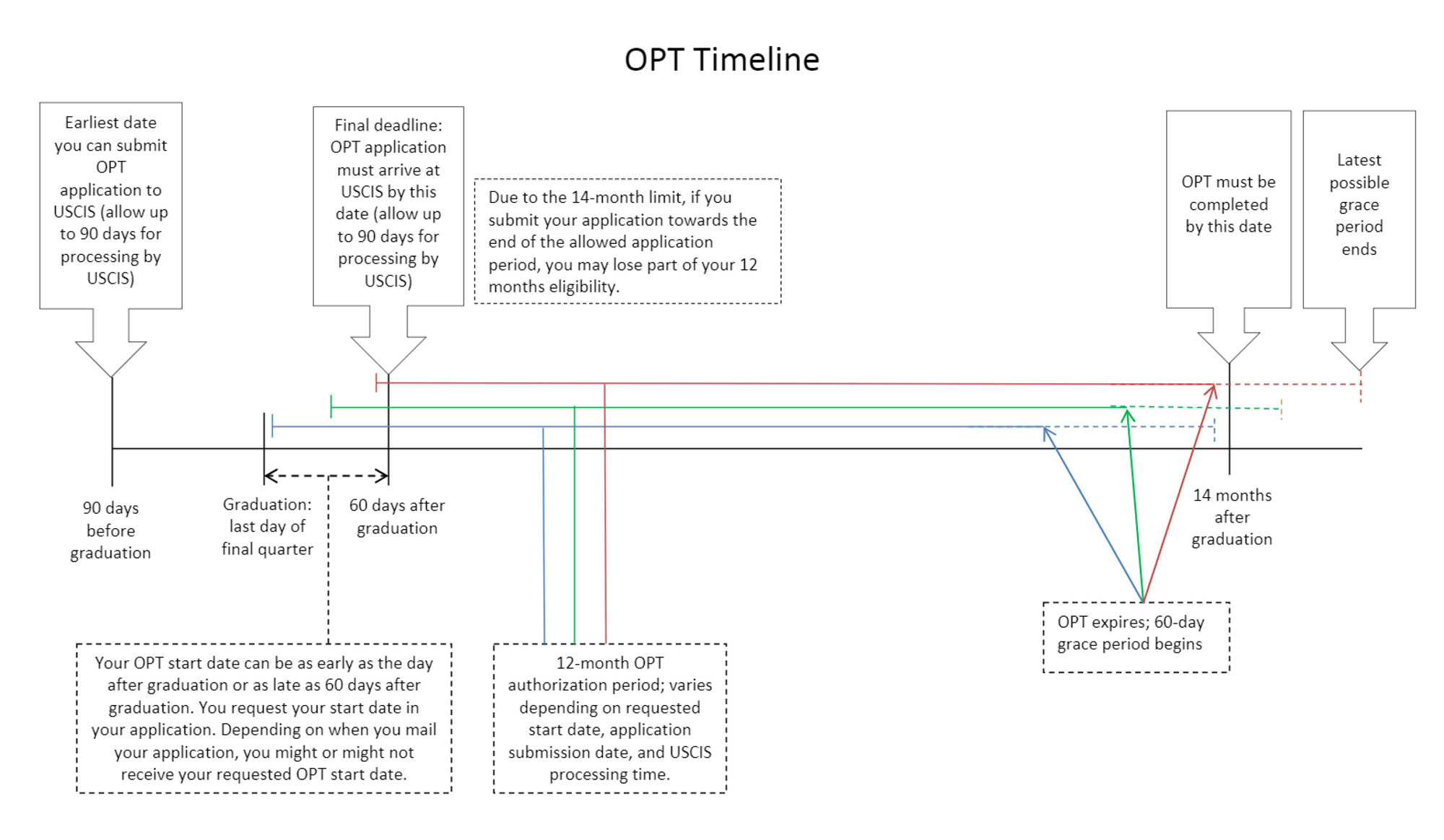A Resource Students Can Share
Last year brought about a worldwide pandemic and a host of anti-immigrant legal changes to the U.S. This year is treating students to unprecedented processing delays and still more legal changes. It’s no wonder many international students are beginning to doubt their futures here.
But before current international students in the U.S. book their flights home, students should consider the long-term. Opportunity still knocks, especially for students looking to graduate this spring. Work experience will always be valuable, and the OPT program remains open to those looking to step confidently onto their career path in the U.S.
What is OPT?
Optional Practical Training (OPT), allows international students to gain on-the-job experience in their field of study. Eligible F-1 visa students qualify for 12 months of OPT, which they can use either before or after graduation. Most will choose post-completion OPT and are able to provide an Employment Authorization Document (EAD) showing start and end dates corresponding to their period of legal employment in their major field of study. However, students who receive a qualifying bachelor’s degree (or higher) in a STEM field can take an additional 24-month extension through the STEM OPT program. For both programs, international students must graduate from a Student and Exchange Visitor Program (SEVP)-certified institution.
In recent years, OPT has become an even more popular option than the H-1B visa program. Unlike H-1B visas, the OPT program doesn’t require employer sponsorship, nor does it cap the maximum number of participants. For further reading, we recommend this FAQ page from the National Association of Graduate-Professional Students.
Who is Eligible for OPT?
Besides attending or graduating from a SEVP-certified institution, international students who want to apply for OPT must meet the following criteria:
- They have completed a minimum of one academic year as a full-time student by the requested OPT start date AND
- They maintain a valid F-1 status during the application process AND
- They have not previously completed OPT time at the same degree level.
What is the Biggest Challenge for OPT Applicants?
The biggest challenge for applicants today is something they have no control over: long processing times.
In January of 2021, USCIS issued an alert indicating the large number of applications received, combined with an overwhelmed postal service and restrictions related to the COVID pandemic, are causing significant delays, especially for F-1 students filing for Employment Authorization. As of early 2021, students are waiting 4 to 8 weeks for a receipt, and applications are taking anywhere from 3 to 8 months to process.
It is important to remember that these processing delays will not impact the received date, which is postmarked on all applications on the day of their arrival at the lockbox. Lockbox processing times can be found at any time on this USCIS webpage. The USCIS recommends waiting a minimum of 8 weeks before contacting them regarding an OPT case.
How Does OPT Benefit International Students?
As many international students take to Twitter to vent their frustrations, others may be left questioning whether the OPT program is even a good fit for them anymore. This is a huge shift in mindset, especially since a 2017 survey showed 73% of students chose to study in the United States because of the opportunity to gain U.S. work experience.
While these delays can be both stressful and scary, there are still a lot of upsides to the OPT program to remember:
- Students can use the OPT program to extend their stay in the U.S.
- Students can gain paid (or unpaid) experience in their field of study.
- Students can negotiate a more permanent job with employers willing to sponsor work visas.
- Students in the OPT program pay less in taxes than those with an H-1B visa.
When Should an International Student Apply for OPT?
The OPT timeline varies according to the type of extension you will be filing for:
- Students filing for pre-completion OPT may apply up to 90 days before completing their full academic year, but only after their designated school official (DSO) enters the recommendation into their SEVIS record. Remember, the OPT cannot begin until after the full academic year has been completed.
- Students filing for post-completion OPT may apply up to 90 days before and 60 days after completing their degree, and must do so within 30 days of their DSO entering the recommendation into their SEVIS record.
- Students filing for the STEM extension may apply up to 90 days before their current OPT program expires, and must do so within 60 days of their DSO entering the recommendation into their SEVIS record.
International students can use this OPT timeline calculator to calculate their grace period and recommended OPT start date based on their current academic program. Students can also use this timeline as a visual reference:
How Does an International Student Complete Their OPT Application?
As international students close in on Spring 2021 graduation, now is a great time to discuss OPT with their advisors. If OPT is the right option, the DSO begins the application process by endorsing Form I‑20 (Certification of Eligibility for Nonimmigrant Student Status) and recommending the student for OPT in SEVIS.
Students need to complete Form I-765 (Application for Employment Authorization with USCIS), supply the required documentation, and pay the $410 filing fee before their deadline. Students can access detailed instructions on the USCIS website (under “Forms and Document Downloads”) and reach out to their advisors with questions. Once the application is submitted, students can track its progress at the USCIS Case Status webpage using their receipt number.
How Does an International Student Remain Insured When Transitioning to OPT?
As international students move forward with their OPT applications, it is important to have a conversation about health insurance. Many students may not realize that their F-1 health insurance will expire when their time as a full-time student comes to an end. And even if they begin their OPT the day after graduation, many companies enforce a waiting period where new hires remain uninsured for 30 to 90 days. The problem is, students still need coverage and protection during this gap. Going uninsured in the U.S. is highly risky and could result in hundreds of thousands or even millions of dollars in medical bills.
The solution is OPT health insurance from Lewerglobal. Our plans are built specifically for international students, and the OPT plan is built especially for this gap in coverage. If you have questions or want to discuss OPT health insurance in more detail, you can contact us via email and live chat on our website.
Key Takeaway
While legal changes and delays have been making trouble for international students, OPT remains a highly valuable opportunity. As the situation progresses, we are hopeful that students will still choose to move forward with OPT, knowing Lewerglobal OPT Health Insurance has them covered.
The information provided on this website does not, and is not intended to, constitute legal advice. All information, content, and materials available on this site are for general informational purposes only. Information on this website may not constitute the most up-to-date legal or other information. This website contains links to other third-party websites. Such links are only for the convenience of the reader; The Lewer Companies does not recommend or endorse the contents of third-party sites. Readers of this website should contact their attorney to obtain advice with respect to any particular legal matter. No reader should act or refrain from acting on the basis of information on this site without first seeking legal advice from counsel in the relevant jurisdiction. Use of, and access to, this website or any of the links or resources contained within the site do not create an attorney-client relationship between the reader and website authors, contributors, or committee members and their respective employees.
This article is an update to a previously published blog post titled “For Advisors: OPT and Navigating the Student Transition.” Read the original post here.
Processing issues surrounding Optional Practical Training (OPT) persist in the wake of COVID-19 and the end of the last U.S. presidential administration. In response, schools and their international student advisors are working at a frenetic pace to deliver sound advice and help students make the transition from school to the workplace as smooth as possible.
Here are three items that help frame a meaningful OPT gap conversation with your students:
1. Understand the Current Climate and Proactively Assist Students
In response to the pandemic, international student admissions have declined precipitously. According to the Institute of International Education® (IIE), total enrollment for international students, both in-person and online, decreased by 16 percent in Fall 2020. New international student enrollment was hit even harder with a 43 percent decrease. The silver lining comes in the form of deferrals. Ninety percent of surveyed institutions reported international student deferrals for Fall 2020, accounting for nearly 40,000 students who will hopefully come to study in the U.S. at a later date. With these decreases in admissions, a significant decline in OPT is likely also on the horizon.
However, a natural return to normal enrollment alone may not be enough to bring students back amidst a climate that has been hostile for the past four years. One proactive improvement international offices can make is paying attention to what international students find important. As a highly popular feature of their F-1 visa status, international students understand how a post-completion EAD can help establish their professional careers in the U.S.—or at least gain on-the-job experience before heading home. As of this writing, OPT application numbers are still strong, and requests are continuing to be reviewed, albeit very slowly. COVID-19 restrictions, a significant increase in certain benefit requests, and the utter inundation of the U.S. postal service are causing major delays at USCIS lockboxes. Despite lawsuits challenging these errors, These delays are causing the loss of jobs and job offers and threatening the immigration status for many international students. International students should be advised of these delays entering their final semester so they can prepare for the application costs and documents required to file their application and not wait until final filing deadlines so as to avoid an unfortunate scenario like Berkeley faced.

2. Navigate the Timeline
Lockbox delays have prompted U.S. Citizenship and Immigration Services (USCIS) to issue flexibilities regarding OPT periods and applications. Specifically:
- The 14-month OPT completion timeline will now begin on the date of students’ Form I-765 approval instead of the end of their academic program.
- Students who receive Form I-765 approval for less than the amount of time originally requested can request a correction to their Employment Authorization Document (EAD). USCIS will issue a new EAD with the corrected date to cover the full amount of requested OPT time.
- The deadline for refiling a rejected Form I-765 has been extended to May 31, 2021, provided the original filing was received between Oct. 1, 2020 and May 1, 2021 and consequently rejected. USCIS recommends including a copy of the rejection notice with your second filing.
- If the lockbox inadvertently accepts a Form I-765 with a missing or deficient signature, a Request for Evidence will be issued rather than a denial.
Communicating the changes will help students understand their role and responsibilities in a timely filing of their I-765 application and therefore reduce the amount of gap period between their graduation date and the start of their employment.
3. Fill The Gap
Besides advising on the filing and refiling of OPT applications, it’s important for advisors to remind students of the potential intermission between student and employee that may leave graduated international students without income and health insurance.
When an international student graduates, their eligibility for F-1 health insurance may run out depending on the policy in place at their school. And even if a student files their OPT application on the first possible date with a start date for the Monday following graduation, receives the EAD in time, has a job offer in hand for that following Monday, and their new company offers great health insurance, they may still be without health insurance if their new company has a mandatory waiting period. In the employer world, it is normal for new hires to wait a period of 30 to 90 days after their start date – in such time they are not eligible for the company’s group health insurance coverage. This is why OPT health insurance is vital to your students’ transition plans. OPT health insurance fills this gap, meaning your students are still protected, even if their filing gets delayed at a lockbox. This avoids the very real and painful conversation of a former student begging to “get back on” your health insurance coverage likely due to an emergency already incurred!
Key Takeaway
A lot goes into helping an international student navigate the transition between graduation and a new job. Lewerglobal aids in this transition by offering high-quality health insurance designed specifically for their situation. You can learn more about OPT health insurance at this link or contact us by email or live chat today.
The information provided on this website does not, and is not intended to, constitute legal advice. All information, content, and materials available on this site are for general informational purposes only. Information on this website may not constitute the most up-to-date legal or other information. This website contains links to other third-party websites. Such links are only for the convenience of the reader; The Lewer Companies does not recommend or endorse the contents of third-party sites. Readers of this website should contact their attorney to obtain advice with respect to any particular legal matter. No reader should act or refrain from acting on the basis of information on this site without first seeking legal advice from counsel in the relevant jurisdiction. Use of, and access to, this website or any of the links or resources contained within the site do not create an attorney-client relationship between the reader and website authors, contributors, or committee members and their respective employees.
Last year, Kathleen spoke online to international students at Texas A&M. The questions they asked are common ones, so we’re running them in hopes that they help you with your situation. Our first batch dealt primarily with H-1B visas; this batch deal with F-1 visas and Optional Practical Training (OPT).
These answers are the first words—not the last words—on these issues, and if you have any questions, consult an experienced, reputable immigration lawyer.
If my F-1 status is about to end and I’m pending a Change Of Status, am I legally able to stay within the United States?
If you were in status at the time your change of status was filed, and you timely filed the change of status, then the pending change of status is a period of authorized stay.
If I am pending a Change Of Status and it is rejected, when does the unlawful presence start to accrue? The date of rejection or the date the previous status expired?
It depends on the status you held at the time of the filing, and the actions you take after a rejection—like re-filing—could make a difference. From a very conservative point of view, I would say that your violation of status began once your initial status ran out. Your unlawful presence, however, only begins when your I-94 expires or there is a finding of a violation of status from the agency. An application rejected in the mailroom and not based on the merits is not the same thing as a finding of a violation of status.
I am a Fulbright Graduate Student (sponsored by U.S. and my government financially). How much is it possible for me to request wavier for 2-year home residence rule if I get a job in academia?
It is notoriously difficult to get a waiver of the home residence requirement when you have a Fulbright. A route that may succeed is to find an interested government agency (IGA) to sponsor a waiver. Historically, NASA, the FDA, the military, and many others will support such a waiver. Each agency has very different rules about when they will sponsor a waiver. A job in academia is not sufficient for a waiver, but grants/funding/research that fit within the scope of an IGA can support a waiver.
Does an I-485 petition disqualify me from applying for OPT / STEM?
No. However, you cannot travel as an F-1 with an I-485 pending. The timing of the OPT can get tricky, and if you have already received a work card through the I-485, you may run into confusion or push back from USCIS. If you have used the work card through the I-485, there may be issues about OPT eligibility to look at. Your best course of action is to get all your paperwork together and discuss with a lawyer.
Can being on OPT allow students to self-petition for a green card or is it required to be on H-1B to do so?
You can file a self-petition while in OPT status. However, filing a petition for permanent residence shows you have immigrant intent. You should not travel in OPT or F-1 if you are filing for residence.
I am a minority in my country and in certain portions of my country, people like me aren’t treated well at all. I have not gone back to my country for past three years. I wanted to know how likely it would be for a PhD graduate with F-1 status to apply for permanent residency.
This is very fact specific. Your chances with a self-petition really depend on your field, and your awards/success/publications/endeavor. Put together a very thorough CV. List every award, grant, accomplishment, invitation, you have ever received, and then meet with a lawyer. Do get opinions from different lawyers about the chances of success.
What are the ways one can improve their chances to get a Green Card in a research field? What might be some criteria to look for in a EB1 petition so that one can pursue that route in their research career?
My general advice is to say “Yes.” Say yes to reviewing, editing, serving on committees, being listed in grants, mentoring, collaborating, etc. Make friends and colleagues across the aisle. By that, I mean try to work with people who aren’t just like you, who aren’t from the same country or school or hyper-specialty. Don’t be afraid to introduce yourself to people in your field that you admire. Letters of recommendation are a huge part of the immigration self-petition process. Apply for everything. No grant or award is too small. This includes micro private sector grants.






